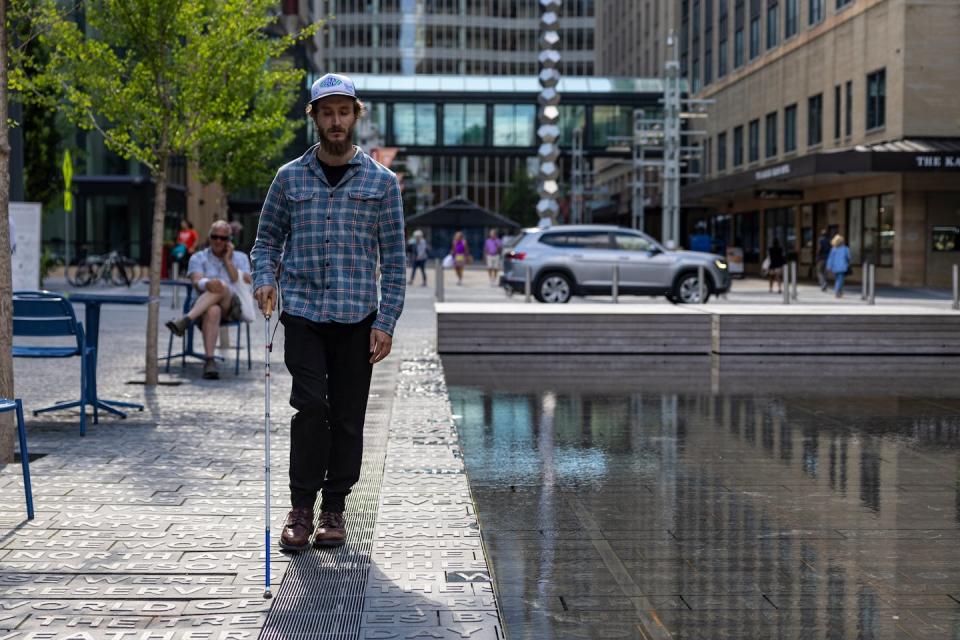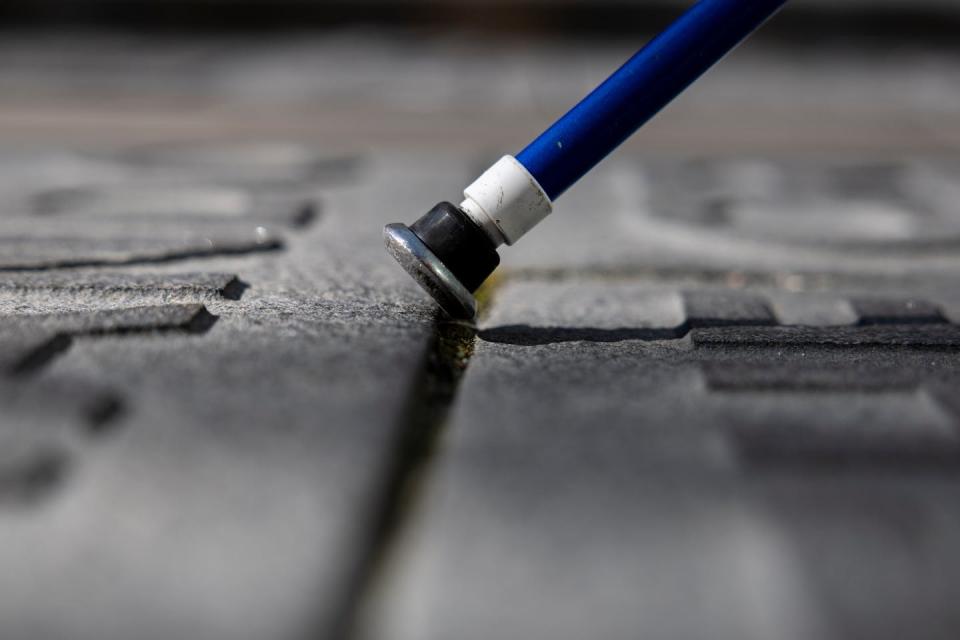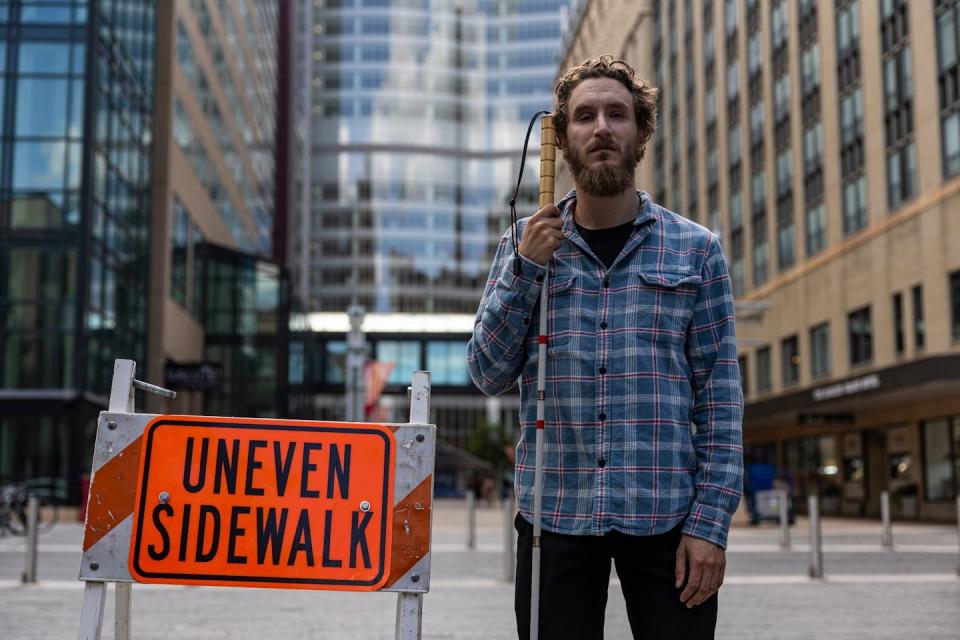Rochester's redesigned Peace Plaza raises accessibility concerns
- Oops!Something went wrong.Please try again later.
ROCHESTER — From a patio seat on Peace Plaza, Chris Mathews smiles as he hears children playing in a nearby water feature. He pauses for reflection as mist comes over the plaza signaling a birth or death at Mayo Clinic. The water feature and the mist are recent additions to the plaza as part of the city's $19.4 million Heart of the City project.
"I love the ideas behind everything that was put into each step of it," Mathews said of the updated plaza.
Still, Mathews, who is legally blind, can't help but shake his head. While the new installations offer a more immersive experience, they do not make up for what he views as the major flaw of the redesigned space.
"The execution of all this really turned into something that isn't accessible," he said.
Mathews is among disability advocates who have expressed concerns about mobility issues on the plaza ever since it reopened to the public in 2022. They point to wheelchairs and walkers getting stuck in the raised letterings on pavers that make up a poetry installation by artist Ann Hamilton. And increasingly, they point out bricks on the plaza that have begun to shift and sink — creating tripping hazards for the mobility-impaired.
But mostly, they question why in a city that draws more than 1 million health care visitors annually — many of them using crutches, canes and walkers — more consideration wasn't given to individuals with accessibility challenges.
"We are in a place that should be the beacon for the country, if not the world, in terms of not just being accessible because we need to get people in the door — but because it's a point of pride," said Mathews.
The comments have not fallen on deaf ears. City officials have begun exploring potential solutions to addressing concerns with the pavers, from grinding down raised letters that exceed the 1/16-inch threshold, to testing the soil to find out why pavers on portions of the plaza are settling.
Josh Johnsen, Rochester's strategic initiatives director, said the goal is to not only to correct the issues within the plaza, but also to find ways to mitigate potential challenges down the road.
"We can't ignore the feedback that people would like a larger, clear walking space where the heaviest traffic is occurring in the plaza," Johnsen said. "We have a sensitive population that comes to Rochester, and we need to be mindful of their accessibility needs."
Balancing art and accessibility
Public art was a key priority for city and Destination Medical Center (DMC) leaders when designing the latest iteration of Peace Plaza, so much so that $3 million was spent to bring in renowned artists such as Hamilton, whose large-scale public works include a memorial at the subway level of the World Trade Center site in New York City.
For her Rochester installation, "A Song for Water," Hamilton weaved together fragments and phrases based on writings by Gwen Westerman, a Dakota educator and writer who was appointed as the state's poet laureate in 2021. Using raised letters on granite pavers, the art stretches over 250 feet of the plaza, from the Peace Fountain across First Avenue.
To ensure ADA compliance, city and DMC officials said they brought in people with various mobility challenges to test out the surface on a prototype in the basement of the Rochester Art Center. The experience led to the determination that the raised letterings should be no more than 1/16 of an inch above the surface.
"Early on, we took a lot of effort to ensure that it would be ADA-compliant and that it would be traversable for people of all ages and abilities," said Johnsen.
Rochester Mayor Kim Norton,who as a member of the DMC Corporation Board approved the final design, said she was assured at the time the installation would not be an issue. But within months of its opening in 2022, social media threads began to fill up with hundreds of comments about the hazard of the raised letterings.
Since then, Norton said she has heard from at least a couple of people who have fallen on the plaza as a result of the uneven surfaces. She said the goal moving forward is to find solutions for addressing concerns related to mobility — such as grinding down uneven letters — while also ensuring that art remains a central component of the plaza experience.
"We are trying to find that happy medium between having something that is beautiful and creative and artistic, and having something that is absolutely safe for every person, whether you have a disability or not, to use it," said Norton.
Falling short of expectations
Tristan Soll, who navigates the downtown daily on his wheelchair, said the raised letters are only part of the problem with the plaza. The bigger issue, he said, is the settling of the pavers, which at various points has resulted in sinking, shifting and dislocated bricks. The problem has led the city to put up signs warning of uneven surfaces.
"The plaza looked really nice for the first couple of months. But with the seasons changing, you can notice the bricks shifting," said Soll, who became disabled after a car crash in 2018. "I try to avoid this whole part of downtown."
Soll, who has seen firsthand people with walkers and canes trip and stumble on the plaza, said he believes people with medical needs were overlooked in the design process as officials prioritized aesthetics over accessibility.
"It's one thing to be [ADA] compliant," said Soll. "It's another thing to be a destination where people want to come."
Patrick Seeb, executive director of DMC, said he has heard concerns about the plaza's accessibility and acknowledged he "isn't happy about how it is performing." His office is now working with the city to review a third-party engineering report to understand what is driving issues with the pavers settling, what potential costs may look like, and whether there is any liability on part of the original contractors.
Seeb also conceded that a 12-foot path around the art installation could have been executed differently.
"To do it over, we would have created a more clear, smooth dedicated walkway that runs around the perimeter," said Seeb. "So, for people who want to engage in the art and scrim pool, they can choose to do so. And that was the intent, but it still didn't live up to our expectations."
As solutions are weighed for Peace Plaza, Seeb and city officials said lessons learned from the Heart of the City project are already being applied to other parts of downtown, notably the nearby Discovery Walk project, a reconstructed pedestrian corridor connecting Mayo's campus with Soldiers Field Park.
With Discovery Walk, pavers were scrapped in some areas in favor of a clear concrete path that runs along the entire four-block corridor.
"The whole goal is not just to complete a project and move onto the next one," said Johnsen. "The goal is to complete a project, analyze the project, understand what worked, what can be improved, and then use that information for future projects."
Mathews, who documents his experiences navigating by cane for his YouTube channel BlindOverMatter, said he hopes the issues at Peace Plaza do more than lead to changes on the surface — but also spark conversations about how downtown can become a place that prioritizes the accessibility of its most vulnerable visitors.
"I think in Rochester a lot of times what happens is things are designed and it looks cool, and it gets the funding, and it's put into place," said Mathews. "And then somebody has to raise a fuss and say, 'No, this doesn't work.'
"There has to be a better way."



